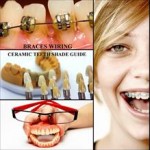The process of using ceramic materials to replace or repair teeth is not new. According to the Indiana University School of Dentistry, the first porcelain denture tooth was introduced in 1789. Of the materials used today for tooth restoration, ceramic porcelain comes closest to duplicating the color and translucency of natural teeth. Ceramic teeth are, however, more expensive than other materials and can add up to a major investment. Protect your investment and help your ceramic teeth last longer by cleaning them properly.
Uses of ceramic in modern dentistry

Current applications of ceramics in dentistry include fillings, crowns, veneers, implants and dental brackets.
Current applications of ceramics in dentistry include fillings, crowns, veneers, implants and dental brackets.
Fillings
Traditionally filling have been made from silver/tin/mercury amalgams. However, resin based filling materials are rapidly gaining in popularity for health and aesthetic reasons.
These resins are usually filled with 35-85% ceramic fillers such as silicate glasses, colloidal silica or quartz. Despite the advantages of using ceramic filled resins, these materials may be susceptibe to wear when applied to chewing surfaces.
For this reason, all-ceramic inlays, onlays and crowns are also gaining in popularity. CAD-CAM systems are also becoming more popular allow dentists to machine dental ceramic blanks to suit individual patients and fir them in the same visit. Materials that are suitable for this application include:
•        Leucite reinforced feldspathic porcelain
•        Alumina with continuously interconnected porosity, infiltrated with lanthanum aluminosilicate glass, after machining to provide translucency
•        Glass infiltrated porous spinel
•        Glass infiltrated porous zirconia
Crowns and Veneers
Porcelain fused to metal (PFM) materials constitute about 75% all crowns in a market consuming about 30 million crowns in the USA alone. The porcelain used is a feldspathic porcelain. The porcelain contains varying amounts of crystallised leucite. The amount of crystallised leucite influences properties such as strength and thermal expansion. Thermal expansion is critical in the manufacture PFM implants to avoid cracking of the ceramic, which could lead to failure during manufacture or in operation.
PFM materials are also used for veneers to cover damaged front teeth and crowns, although ceramic cores are being used in some crowns. All ceramic crowns are normally coated with porcelain so that colour and translucency can be matched.
Dental Implants
Dental implants are used as an alternative to bridges where a tooth has been lost or removed. These are also made of PFM, where a biocompatible metal post made out a material such as titanium is anchored into the jaw bone and the porcelain crown is affixed to the post.
The metal post may also be coated with hydroxyapatite to aid bone bonding and rapid osseointegration. Bioglass posts are sometimes used for this purpose for the same reason.
The most recent use for ceramics in dentistry is orthodontic brackets. The development and demand for these items has been driven solely by aesthetics. Polycrystalline alumina is the material of choice in this application.
Instructions
Things You’ll Need
- Toothbrush with soft bristles
- Toothpaste, low abrasive
- Electric toothbrush with soft bristles
- Dental floss
-
Brush your teeth, including your ceramic teeth, twice a day. Use a soft-bristled toothbrush to avoid scratching the ceramic teeth. Clean around your gum line carefully. Also try to clean after every meal. If you clean your teeth regularly and conscientiously, you have less chance of keeping stains on your teeth.
- Rinse, rinse, rinse. Â After every meal, rinse the food from your teeth if brushing is not possible. If you can’t get to a restroom, pick up your water glass, take a swig, then rinse and swallow at the table.
- Choose a toothpaste that is low on the abrasive RDA index. Toothpastes that rate 45 or below on the index are gentle enough for ceramic teeth. Contact the toothpaste manufacturer, using the contact information on the box or tube of toothpaste, to find out the abrasiveness rating. Use Gel-Kam to help with sensitive or cavity prone teeth. Avoid “extra whitening” toothpaste because they are often very abrasive and can scratch your restoration.
- Use an electric toothbrush, if you prefer, with soft bristles. Never use an ultrasonic toothbrush; the vibrations can loosen ceramic bonding agents.
-
Floss your teeth once a day. Usually, flossing before bedtime is the best time. Use care when flossing around your ceramic teeth, and do not pull on the edges of the ceramic work. Visit your dentist as soon as possible if you feel any snags while flossing.
- Fine scratches can be polished with Novus Plastic polish or toothpaste, but with toothpaste it is slower.
- Visit a dental hygienist for professional, periodic cleanings as often as your dentist recommends. Use only dental hygienists who have training in cleaning ceramic teeth. Many of the traditional methods to clean natural teeth may permanently damage ceramic teeth.
Tips & Warnings
- If you use a mouthwash as part of your teeth-cleaning regimen, choose a mouthwash that does not contain alcohol. Alcohol may soften and loosen ceramic bonding agents.


i implanted dental bridge 2 days ago nd m still wondering if its the rite move as i am afraid of black tatoo on my teeth tht can be caused by metal in this crown, m also thinkinking of allergies nd cancer plis help how can i take care of my bride to last long?
Very few people are allergic to metal crowns. but if u experience any symptoms such as rashes near to your metal crown, do go back to your dentist. as for cancer, so far there has been no cases of cancer caused by metal crowns or dental bridges. Have you expressed your concerns to your dentist before or after the procedure? your dentist is the best person to talk to in this kind of situation, but I will try to help.
as for taking care of your dental bridge, again, you should be asking your dentist this question. However, here is a site that can help you.
http://www.ehow.com/how_5124975_care-dental-bridge.html